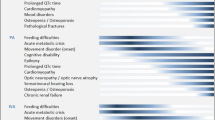Abstract.
To determine the incidence of renal functional abnormalities after lead poisoning, we evaluated the parameters of renal tubular function in 134 children and young adults, 8–13 years after chelation therapy for severe lead poisoning. There was no evidence of hypertension or reduced kidney function as assessed by serum creatinine (Cr) concentrations. Urinary α-amino nitrogen (Uaan) concentrations were significantly increased compared with 19 healthy age-matched controls. Ninety-four children (70%) had aminoaciduria (Uaan/Cr >0.23). Urinary glucose excretion was also significantly higher than that of 2 historical controls. Thirty-two children (24%) had glycosuria (>125 mg/24 h). Fractional excretion of phosphate was normal in all children. We conclude that a partial Fanconi syndrome can persist up to 13 years after childhood lead poisoning.
Similar content being viewed by others
Author information
Authors and Affiliations
Additional information
Received August 11, 1997; received in revised form November 20, 1997; accepted November 21, 1997
Rights and permissions
About this article
Cite this article
Loghman-Adham, M. Aminoaciduria and glycosuria following severe childhood lead poisoning. Pediatr Nephrol 12, 218–221 (1998). https://doi.org/10.1007/s004670050441
Issue Date:
DOI: https://doi.org/10.1007/s004670050441




